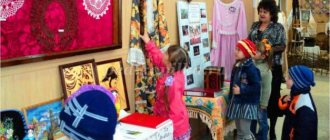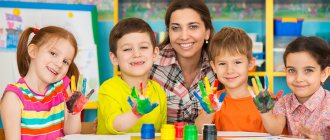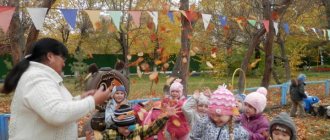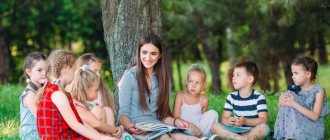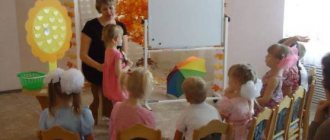This presentation will be of interest to teachers working in preschool institutions; environmental education is one of the important components in the education process.
The work is addressed to teachers of preschool institutions, and students of pedagogical faculties can also use it.
The presentation reflects a developing subject-spatial environment, organized to form the principles of ecological culture in children of primary preschool age.
Speech for presentation
SLIDE 1 Hello, dear colleagues.
The topic of my speech is “Modern approaches to the formation of the principles of environmental culture in children of primary preschool age.” She started working with children aged 2-4 years in 2013.
As we all know, people living in modern society have many problems. But perhaps one of the most acute and pressing is the problem of environmental conservation. We are already accustomed to conversations that the world is on the brink of an environmental catastrophe, that more and more new species of plants and animals are disappearing from the earth, and that we are physically suffering from air, water, and soil pollution.
SLIDE 2 In order to attract public attention to the issues of environmental development of the Russian Federation, conservation of biological diversity and ensuring environmental safety, 2022 has been declared the year of ECOLOGY in Russia.
I believe that the foundations of environmental education should be laid in early preschool age.
In the process of environmental education, children develop cognitive interest in the natural world, curiosity, and creative activity.
One of the important components of environmental education is a developing subject-spatial environment. To begin with, I would like to say a few words about the conditions that have been created in our preschool educational institution.
SLIDE 3
For five years, our kindergarten has been working in a priority area - the cognitive development of preschoolers, in particular environmental education. To develop an emotional and value-based attitude towards the nature around us, our kindergarten teachers have created an ecological room. Slide 4 At the entrance we are always greeted by the owner of the room “Mushroom - Borovik”.
SLIDE 5
The following zones are allocated in the ecological room :
1. Collections and display materials area . Slide 6-7 This zone is intended to introduce children to various natural objects, to develop their sensory skills, skills of classifying objects according to various criteria. The collection material also serves as visual material.
2. Library area. SLIDE 8
this is a corner in which colorful books, encyclopedias for children, children's atlases, homemade books on the topic: “Nature through the eyes of children” based on the works of Vitaly Bianki, Evgeny Charushin, and other writers are collected.
SLIDE 9 Next to the library area there is an exhibition of reproductions of paintings by great landscape artists, and next to them are works of our students, possibly future great artists.
3. Russia includes almost all climatic zones that exist on earth. SLIDE 10 Designed natural climatic zones : Arctic, forest-steppe, tundra, desert, tropics allow preschoolers to be introduced to the plants and animals of our country.
4. Laboratory area SLIDE 11
Here conditions have been created for the development of cognitive and research activities in children, the formation of the foundations of a scientific worldview. Working in the laboratory involves turning children into scientists who conduct experiments, experiments, and observations on various topics.
5. Relaxation area . SLIDE 12
Helps relieve tension or fatigue in children, which arises as a result of receiving a huge amount of information. A stream and indoor plants are presented here. The murmuring of the stream and quiet music encourage children to relax and play independently.
an experimental plot has been created on the territory of our preschool institution , where pupils carry out experimental research activities, observe the growth of various plants and how to care for them, grow onions and herbs in the garden for our table, and instill the first labor skills.
There is also an ecological trail here,
SLIDE 14 with a length of about 500 meters, which performs cognitive, developmental, aesthetic and health-improving functions. Helps to develop in children a conscious attitude towards their native nature, since children take an active part in the creation and preservation of natural resources.
SLIDE 15 There is non-standard equipment on the ecological trail.
SLIDE 16 I use the created developmental subject-spatial environment in the formation of the beginnings of the ecological culture of younger preschoolers.
Younger preschool age is the most valuable stage in the development of the beginnings of children's ecological culture.
SLIDE 17 Objects of nature attract children, first of all, with their beauty, bright colors, variety, and this is the source of the first concrete knowledge and joyful experiences, often remembered for a lifetime.
Familiarization with the natural world is one of the sections of cognitive development, and therefore there is a need for its integration into other educational areas.
Social and communicative development. The introduction of a new educational standard orients teachers towards the playful nature of the educational process, since play is the most accessible and interesting activity for a preschooler. In order to form in children a sense of belonging to all living things, to instill in children responsibility towards every living being, be it a plant or an animal, I began to use environmental and psychological trainings.
SLIDE 18 For a few minutes, the children and I “turn” into bugs, butterflies, ladybugs, kittens and bunnies.
SLIDE 18 After experiencing emotions, the child can relax in the “Retreat Center”.
One of the favorite forms for children was interviewing. Listen to how the children of the 2nd junior group answered the question “What is nature?”
Cognitive development.
SLIDE 19 To work with children in a group, I organized an ecological space “Nature Center”, which includes a nature calendar; library; dummies of vegetables and fruits; games: didactic, board-printed, dramatization games, various illustrations and reproductions about nature, the seasons, domestic and wild animals were selected.
SLIDE 20. In the experimentation center, children can conduct experiments with water and sand at any time; study their properties, play with them, show creative qualities, develop imagination, as well as fine motor skills.
Slide 21 The “Vegetable Garden on the Window” project allows you to expand children’s understanding of plants, where they grow, the necessary conditions for their growth, and develop their interest in cognitive and research activities.
SLIDE 22 To gain primary knowledge, get acquainted with nature, and strengthen children’s skills, I developed a model of a “Village Yard” consisting of models of domestic animals
SLIDE 23 One of the effective methods when working with children to form the principles of environmental culture is the project method. In my work, I implemented the projects “Indoor Plants” and “Magic Drop”. The goal of the “Indoor Plants” project was to form ideas about living conditions in rooms. plants, rules for caring for them. The goal of the “Magic Drops” project is to form ideas about the properties of water, the role of water in human life and other living organisms; fostering a caring attitude towards the natural resources of our planet.
As part of the “Indoor Plants” project, I organized the “Give a Plant to a Kindergarten” campaign and the “Bereginya” resource-saving campaign, the goal of which was to form an environmental culture and worldview in children and adults and to cultivate a careful attitude towards water.
Speech development.
SLIDE 24 Nature is a rich source of aesthetic experiences and vocabulary development for preschoolers. The simplest thing I started with was reading good fairy tales about animals, looking at pictures of animals, birds and plants. In addition to fairy tales, I use other works of folklore, poems, the plots of which are played out with children. In the mummers corner, children are happy to change their appearance, dressing up in animal costumes, their favorite fairy-tale characters, where they feel relaxed and free. The speech of younger preschoolers also develops well during walks.
SLIDE 25 While walking, kids ask a lot of questions, many of which stimulate the thinking process and require the expression of emotions and thoughts using words.
Physical development
SLIDE 26 Physical education and health work also contributes to the environmental education of children through physical education classes, physical education holidays, leisure activities and excursions, which, on the one hand, promote the development of motor skills and abilities of pupils, strengthen their health, and on the other hand, cultivate a deep understanding of the multifaceted significance of nature for people's lives.
Artistic and aesthetic development
SLIDE 27 Fine art, artistic expression, and music allow us to convey perceived beauty, capture those objects and phenomena that we liked, and share our experiences with loved ones; Their creative activity awakens and develops, creativity is formed.
We all know that children love holidays and entertainment.
SLIDE 28 Their role is to have a strong impact on the emotional sphere of the child’s personality. It is important in such holidays that children are involved in experiencing events, in awareness of environmental problems that are understandable to children.
And yet, instilling in children a positive attitude towards nature is only possible when parents also have an ecological culture. Children behave like the adults around them. Parents need to realize this.
SLIDE 29 Various forms of interaction with parents: surveys, consultations, parent meetings, presentations, trainings, exhibitions, projects, seminars, competitions, leisure activities allow us to combine efforts to develop and educate children in the principles of environmental culture;
SLIDE 30 Thus, I believe that environmental education has a positive effect on the development of a child’s personality: it develops a sense of responsibility for the nature of the native land, fosters a humane attitude towards the environment, and forms initial environmental ideas in children of primary preschool age.
Author: Martynova Ekaterina Sergeevna, teacher at MBDOU DS "Rucheyok" r.p. Bashmakovo, Penza region, Bashmakovsky district, Russia.
The article is published in the author's edition
Presentation on the topic “Forms and methods of environmental education of preschool children” presentation
Slide 1
FORMS AND METHODS OF ECOLOGICAL EDUCATION FOR PRESCHOOL CHILDREN
Slide 3
Observation Among the various methods of environmental education of preschoolers, an important place should be given to observation. Its essence lies in the sensory knowledge of natural objects, in their knowledge through various forms of perception - visual, auditory, tactile, gustatory, olfactory. The seasonal life of plants provides great opportunities for observation. The different conditions of trees and shrubs, the appearance and disappearance of herbaceous vegetation in the warm and cold seasons allow children, in the process of observation, to form ideas about the dependence of plant life on external conditions.
Slide 4
Requirements for conducting observations: 1. Any natural object should be as accessible as possible for perception. The child must see the object himself and everything that happens to it, hear the sounds emanating from it, be able to smell it, and hold it in his hands, if possible. 2. Temporal parameter of observation: examination and perception of any objects and natural phenomena should be short-lived. 3-10 minutes is the optimal time for intensive mental activity of children, for concentrating attention and independently obtaining and assimilating information. Children should begin and complete observation in a positive emotional state, without fatigue. 3. The third requirement is related to the structure of observations. Each of them has a beginning, a main part and an end. The beginning of observation solves a rather difficult task - to gather children and concentrate their attention. In the second, main part, the teacher asks questions and listens to the answers. The end of the observation should be emotional so that the children are in a good mood after it. Then next time they will want to observe themselves, without any special techniques
Slide 5
An excursion is another very interesting form of conducting environmental studies. An excursion is a complex event; it is planned, thought about, and prepared in advance. During the excursion, the mental development of children is influenced by various educational activities: observations of natural phenomena, explanations from adults, word games, guessing riddles.
Slide 6
Work. Interesting and varied work is carried out in the flower garden, vegetable garden, and plot. Children observe plants, practice labor skills (watering plants, loosening, collecting seeds and harvests, etc.). This work has a great influence on the development of hard work, independence and mutual assistance. In senior and preparatory school groups, it is possible to organize site duties in the spring and summer or assign groups of children to a garden bed or flower bed. The teacher conducts work and observations in a corner of nature with children every day. The form of organization of activities is different (depending on age). Children, starting from the younger group, are involved in certain work assignments.
Slide 7
Another form of environmental work in kindergarten is environmental holidays and leisure activities. Ecological holidays can be dedicated to the seasons, harvests, birds, etc.
Slide 8
Didactic games occupy a special place in introducing nature. By solving problems posed in a didactic game, the child learns to isolate individual characteristics of objects and phenomena, compare them, group them, and classify them according to certain general characteristics. Children learn to reason, draw conclusions, generalizations, while their attention, memory, and voluntary perception are trained. . Reading works of fiction about nature, looking at books of encyclopedic content
Slide 10
Environmental education is the education of morality, spirituality, and intelligence. The formation of the ecological culture of the population, the beginning of its formation falls on the first seven to eight years of a child’s life. It is in preschool age that learning the basics of environmental knowledge is most productive, since the child perceives nature very emotionally. The influence of nature on a child is enormous: it greets the baby with a sea of sounds and smells, secrets and riddles, makes him stop, take a closer look, and think. The beauty of the surrounding world gives rise to a feeling of attachment to the place where you were born and live, and, ultimately, love for the Fatherland.
Presentation “Forms and methods of environmental education of preschool children in accordance with the Federal State Educational Standard”
Makhova
Presentation “Forms and methods of environmental education of preschool children in accordance with the Federal State Educational Standard”
Consultation for parents
«Environmental education of preschool children»
The word " ecology "
and its derivatives have become firmly established in our everyday vocabulary, but are understood in different ways.
There are many definitions in the scientific literature. The most common: ecology is the science of the relationships of living organisms with each other and with the environment.
Typically, environmental education is understood as fostering a love for nature . Indeed, this is an important component of the educational process , but often the methods by which such love is cultivated are very questionable. For example, for this purpose, houses contain wild animals or domestic animals without proper care, which get sick and even die in front of children. And children get used to not noticing their torment. Often during summer walks, parents offer to pick flowers, catch butterflies, dragonflies or other insects. Such activities become constant summer fun for the children. They tear off insects' wings, legs, or even trample their prey with their feet. Thus, such educational activities teach children not to love, but to destroy living things, and quite cruelly.
Very often, children learn poems about nature, the content of which contradicts environmentally correct behavior. Taking this into account, it is necessary to emphasize once again that one of the tasks of environmental education is to form in the child an idea of man not as a master, a conqueror of nature, but as a part of nature that depends on it. Strive to eradicate the consumerist attitude towards nature in children.
Currently, most preschoolers have formed a clear division of animals into “bad” ones.
and
“good”
,
“evil”
and
“good”
,
“harmful”
and
“useful”
.
This is facilitated by works of art and cartoons. In many of them, predators are portrayed as evil, bad. They want to eat “good”
hares and piglets.
In them, as a rule, hares defeat wolves and are left to live alone in the forest, without evil predators. Many children are convinced that a predatory animal is bad, nature does not need it, and that a beautiful forest is a forest without wolves (without predators)
.
From an environmental point of view, “bad” things in nature
and
“good”
,
“harmful”
and
“useful”
.
Each animal and plant perform their “work”
and play a certain role in nature. Meanwhile, many once common plants and animals have become rare, our forests, once rich in mushrooms and berries, have become scarce, fertile soil particles are destroyed, water and air are polluted.
We, adults, cannot feel uninvolved in the modern problems of our society. The adults who are responsible for environmental disasters were once children too. It’s a shame that we can’t help but admit: we didn’t raise them .
successfully engage in environmental education only when you know exactly what this means.
Environmental education of children is, first of all, the education of humanity , that is, kindness, a responsible attitude towards nature, and towards the people who live nearby, towards descendants who need to leave the Earth suitable for a full life. Environmental education should teach children to understand themselves and everything that happens around them. We need to teach children how to behave correctly in nature and among people.
Educational tasks are sometimes complicated by the fact that children often see adults violating the basic norms of communication with each other and nature. Probably in such cases it is necessary to say: although they are adults, they do not know that they cannot speak rudely, leave garbage in rest areas, throw garbage while walking, carve inscriptions on tree trunks, or offend homeless animals.
Remember the rules!
— When in nature, you should not pick plants for bouquets. Bouquets can be made from those plants grown by humans.
— You can collect medicinal plants only in places where there are a lot of them.
— In nature, especially in the forest, you need to try to walk along paths so that the plants do not die from trampling.
— It is necessary to protect not only rare plants, but also other, even the most common plants.
— You can’t go close to bird nests. Following your tracks, predators can find and destroy your nests. If you accidentally find yourself near the nest, do not touch it, leave immediately. Otherwise, the parent birds may completely leave the nest.
— If you have a dog, do not take it with you into the forest. She can easily catch flightless chicks and helpless baby animals.
- Do not catch and take home healthy bird chicks and young animals. In nature, adult animals will take care of them.
-DO NOT FORGET that plants provide shelter for animals. Protect the grass, bushes, trees, you help the animals, birds, insects that take refuge in their thickets.
THE WEALTH OF THE NATIVE LANDS IS IN MAN’S HANDS.
REMEMBER THIS!
Presentation “Environmental education of preschool children”
Nadezhda Nikolaevna Konoreva
Presentation “Environmental education of preschool children”
1-word Dear colleagues! I am glad to see you today at our seminar.
2-word Undoubtedly, environmental education must begin from a very early age, since child psychologists consider the age of 2-3 years to be the most susceptible to cognition . It is at this time that the coordinate of the baby’s values and his attitude towards the world around him and himself are formed and confirmed.
3-word It is in preschool age that the acquisition of the basics of environmental knowledge is most productive, since the child perceives nature very emotionally as something living. Raising the ecological culture of preschoolers is a multifaceted , multistructural process.
4 words. When starting to work on this topic, we set ourselves the following goal:
5 words To achieve this goal, you must complete the following tasks, you see them on the screen.
6 words As a result of our work, we want to show children that man is a part of nature, that life without water and air is not possible, and we must appreciate and see the beauty of nature and take care of it.
7 words Working with children, as is known, is regulated by the legal field. As for environmental education , aspects of working with this component are regulated by:
• Law of the Russian Federation “On Education”
;
• Federal Law of the Russian Federation “On the Environment”
;
• GEF DO
8 words the forms of work that we used to achieve our goals in the environmental education of our students on the screen.
9 words Environmental education of children in kindergarten is implemented through five areas: cognitive development, social-communicative, speech, artistic-aesthetic, physical.
10 cl. Cognitive development is an integral part of the environmental education of a preschooler . It is at the stage of preschool childhood that the child receives emotional impressions about nature, accumulates ideas about different forms of life, i.e., the fundamental principles of ecological thinking and consciousness are formed in him, the initial elements of ecological culture are laid. But this happens only under one condition: if the adults raising children themselves have an ecological culture : they understand the problems common to all people and worry about them, show the little person the beautiful world of nature, and help establish relationships with him.
11 words Environmental education shapes a child’s speech. The beauty of native nature on a walk does not leave children indifferent. They talk about what they see, what they feel, thereby enriching the child’s vocabulary. Reading fiction about nature makes a child not only develop memory and thinking, but also touches the emotional strings of the soul.
12 words Social and communicative development is also closely related to ecology . Since this is a complex process during which the child learns the values, traditions, culture of the society or community in which he will live. This is the development of a child’s positive attitude towards himself, other people, and the world around him. And also, by caring for plants, feeding birds during the cold period, collecting natural material for activities, games, and entertainment.
13 syllables Forming in a child the correct attitude towards representatives of fauna and flora also goes through artistic and aesthetic development. And artistic and aesthetic education , for its part, develops in the child a sense of harmony inherent in all natural objects and phenomena. Works of art, reading fiction and entertainment on environmental topics , as well as real nature, serve as the most important means of understanding the world around us.
14 syllables Physical development is also directly related to the surrounding nature, both as a natural hygienic and hardening agent and environment of physical activity, as well as an understanding of the value of a child’s life and health.
15 words When looking for any information, children turn not only to the teacher , but also to their parents. Who also participate in our activities, they try to guide and help with the search for information and materials for our work. And, of course, they participate in it.
16 words Concluding the presentation , let me present you with a list of literature that was the theoretical basis of this project.
17 words Thank you for your attention.
